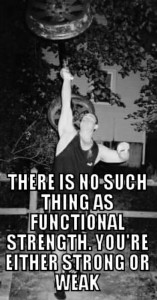Kettlebanding
By John Mckean

Steve Angell, one of IAWA’s strongest ever, displays his own idea of leg training with handled weights on the Dinnie Stones!
Sooo, a Crossfitter and an All-Rounder walk into a bar (a healthful juice bar, of course!). The Crossfit fan can’t help but notice that the IAWA guy is a well seasoned muscular behemoth, yet strolling gracefully, being propelled by amazingly thick thighs. Mr. CF queries, “Really been hitting those “GOBLET squats,” mate??? You know, those modern leg lifts where you hold a fairly heavy kettlebell at chest height and do front squats.” Chuckling, England’s legendary Steve Angell replied, “Heck, that mild conditioning exercise won’t do anything toward building real body power, unless someone happens to construct me a 200K goblet!”
Seriously, though, big Steve did once try a few goblet squats. He’d been doing wrist curls with a 78K globe dumbbell, then flipped the chunk of iron onto his chest to see what this recent fitness fuss was all about. But as one who has officially straddle lifted 680 pounds and Zerchered 555, this tiny gobble seemed less than nothing. Mr. Angell concluded that such iron ball squats, often weighing less than 40K, would be ok for perhaps a few thin, developing teenagers or most “personal trainers,” but would never supply ample resistance for any serious weightlifter.
 For a 70/70 (wt. class/age group!) guy like myself, with each thigh smaller than one of Steve Angell’s huge arms, I’m not about to search for a 440 pound kettlebell just to START progression as Steve would enjoy doing! But his comments did get me thinking of new off-day, or “active rest,” heavy exercise apart from normal all-round workouts. Somewhere around the house, I reasoned, were a few various kettlebells, which I always considered to be just glorified “HANDLES with weight,” probably being used as doorstops. However, with sufficient numbers and strengths of rubber flex bands inserted through that ample handle space it would be simple to build almost any variable resistance that anyone could care for in an exercise! So, derived from a past practice of placing bands over barbells to create a heavier pressure, continuous tension lift, I developed my new experimental combo – “KETTLEBANDS”!
For a 70/70 (wt. class/age group!) guy like myself, with each thigh smaller than one of Steve Angell’s huge arms, I’m not about to search for a 440 pound kettlebell just to START progression as Steve would enjoy doing! But his comments did get me thinking of new off-day, or “active rest,” heavy exercise apart from normal all-round workouts. Somewhere around the house, I reasoned, were a few various kettlebells, which I always considered to be just glorified “HANDLES with weight,” probably being used as doorstops. However, with sufficient numbers and strengths of rubber flex bands inserted through that ample handle space it would be simple to build almost any variable resistance that anyone could care for in an exercise! So, derived from a past practice of placing bands over barbells to create a heavier pressure, continuous tension lift, I developed my new experimental combo – “KETTLEBANDS”!
Well, it turns out that all I needed was the rather sturdy, oblong curved handle of the weighty old globes for the new format of flex band lifting to quickly prove its efficiency! Not only did the extra resistant apparatus cut reps way down to yield planned high intensity training, but at times, with proper banding, had the lift stalling before completion – a true isometric hold. Essentially, I had created a non structured “power rack” that I could use in my living room!! It also became an exciting challenge to develop new & unusual exercises that would benefit from kettlebanding.
One of my favorite new movements is the close grip bent over row – grasp the handle with overhand, underhand, or even cross grip (my favorite!), tramp on the inserted horizontal draped flex bands at your feet (adjust your foot spacing so just enough rubber will allow the lift to begin), and merely do some high tension pulls for 4 reps. Add another band for a follow-up set and just row to mid level (the stubborn additional stretch will stop you!) and hold 3 reps for a few seconds each, for max+ work! Another nifty manuever that seems to be positively influencing my more standard all-round lifts is the Straddle (or Jefferson) lift with a kettleband directly between the legs; again, determine the proper length of band to stand on, left and right, secure a cross grip on the hefty handle then simply rise steadily under this newfound form of tension. You can use heavier ‘bells and more or thicker flex bands here. If you get stuck, hang on for a while and enjoy the isometric! Of course, various forms of curls are a natural while using the combo equipment, and a unique application to the floor press – one or two handed – can be done by placing a band under your lower back, through the handle, with the other band end placed behind your neck; this one is great to quickly reach an iso-hold level which soon proves to be a “burning” method to overload the triceps! I’ll let imagination and ingenuity develop others for your own particular needs and interests!
No kettlebells around the house or gym? Simply obtain one of Al Myers’ sturdy iron rings (or stack two together for better gripping), place it on the center handle of a standard plate loading dumbbell, and build sufficient weight on both sides around it. Remember, it need not be all that heavy – most resistance should come from flex bands! Oh, a dumbbell will tilt and dangle a bit, but one’s fist will hold secure against the inside plate to steady the proceedings, while ring circumference will allow more space and freedom than a short db handle for a firm cross grip. One hand lifts and hook grips can come into play. But any style ring hold offers its own unique feel, challenge, and enjoyable performance. After all, ole supreme physical culturist Steve Angell didn’t complain as he 20 repped with those rings secured on the famous Dinnie stones (combined weight of 785 pounds)! But, hey, just imagine – had Steve carried a few flex bands to Scotland with him, he could’ve saved himself a ton of time by achieving the same workload with only 4 reps!!